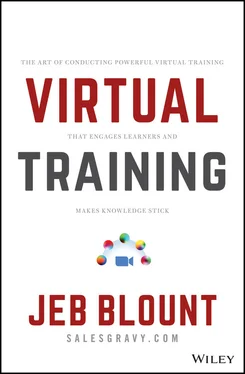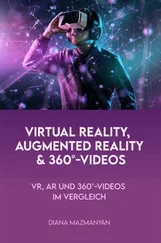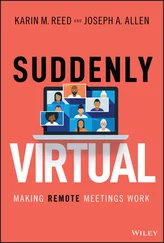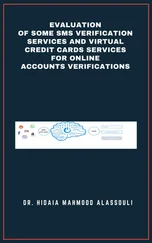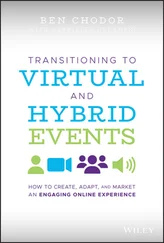I get that the camera makes you feel incredibly self-conscious and insecure. Talking into a camera and being on-screen can unleash deep-rooted fears and be insanely unnerving.
But here's the brutal truth: You have a choice. You can learn to control your fear, anxiety, and insecurity, and master virtual training. Or, you can become irrelevant.
Virtual training is here to stay, and it will become a bigger part of your life. If you refuse to deliver virtual training, you will find yourself unemployed and unemployable. If you lose sight of the mission and don't change your mindset, you will fail to make an impact. Adapt or become extinct. Get the picture?
The Only Three Things You Control
There is no doubt that rising above the emotions that disrupt your confidence in the virtual classroom is a formidable challenge. It's natural to feel intimidated and insecure. It's natural to doubt yourself. It's natural to want to retreat to the physical classroom, where you feel in complete control.
The truth is, there are only three things you can control:
1 Your mindset
2 Your actions
3 Your reactions
That's it—nothing more. You can choose to:
Rise above your fears and insecurities and try.
Get over your self-centered need for validation and instead focus on the mission.
Dust yourself off when you make an embarrassing mistake and try again.
Learn new technology.
Change your attitude and self-talk about being on-screen.
Rise above your emotions and choose your response.
Been There, Done That, Have the T-Shirt
Even though mastering virtual training may seem impossibly difficult, you can do it. I know this because I've had to go through the same steps of acceptance and transformation.
I've had to get past an anguishing fear of the camera, learn how to feel confident while delivering virtual training, and figure out how to see in a virtual classroom like I do in a physical classroom.
At the beginning of my virtual training transformation, even an hour of virtual delivery would leave me mentally exhausted. I'd feel so anxious beforehand that at times I couldn't sleep at night. Nothing felt right. And yet, I survived and kept working at it.
Along the way, slowly but surely, I stretched and grew. Virtual training became easier, energizing, and more natural. I started to feel good about my work. The feedback from learners, who loved the experience, was both motivating and validating.
That's why I know you can do it. All it takes is a decision to shift your mindset to keep the mission in focus. When you change your mindset, you change the game—you can change the way you act and react, even when you feel out of your element. The only thing holding you back is the bullshit story you keep telling yourself about why you can't.
Learning to See in the Virtual Classroom
Professional trainers are virtuosos with people in the classroom. They are masters at reading other people, responding to nuance, and using passion and charisma to connect with learners at the emotional level. They have the ability to intuitively sense the emotions of other people and respond appropriately.
In the classroom, you connect with your learners through perceiving, controlling, managing, and influencing human emotions that are nonconforming and irrational. The feedback you get from your learners helps you know when you are on or off track, and allows you to adjust on the fly.
Making emotional connections in a physical classroom is far easier than in a virtual classroom. You can see the entire picture and quickly flex your communication style to each learner. Relationships with and between learners form much faster. There is less friction, and it is much easier to get into a flow.
When you are standing in a physical classroom, you can see and interpret the entire picture. You see not only your learners but also how they interact with their environment and fellow participants. You have the luxury of reading their eyes, the micro-expressions on their face, and the entirety of their body language. You're also able to read the reactions and nonverbal signals as the learners interact with each other. When you are in a physical classroom, it is easier to:
Make instant connections.
Know when to speed up and slow down.
Flex your communication style and pace to each learner.
Adjust the curriculum and shape it around the unique challenges of the training participants.
Get hands-on and understand your learners real challenges, issues, and problems.
Immerse yourself in breakout exercises.
Communicate clearly and minimize miscommunication.
Know when what you are presenting is off-base or missing the mark.
Accurately read learners and develop coaching questions that provoke awareness, in the moment.
Compare the words that learners say with their nonverbal communication for congruency.
Keep learners engaged, because it is far less likely that they'll drift into social media, look at their email, or become distracted in the physical classroom.
If your primary means of training has always been face-to-face, it's natural to fear that you won't be able to communicate effectively, connect with your learners, or make the same impact in a virtual classroom. You fear that virtual training will lower your effectiveness as an instructor.
This fear is not unfounded. The truth is, the most effective way to build relationships and trust, resolve conflict, brainstorm ideas, collaborate, gain consensus, present ideas, and teach is with physical face-to-face interaction. You know this, and I know this, because we are human.
This is why so many trainers feel out of sorts in the virtual classroom. It's as if their sense of sight has been suddenly taken away—and, in reality, it has.
The eyes manage roughly 80 percent of the information and communication you take in. Visual interpretation of the world and people around you consume at least 50 percent of your brain's computing power. In fact, a far larger part of the brain is dedicated to vision than to hearing, taste, touch, and smell combined. 1 In a virtual classroom, though you may see learners on video, it's cloudy, and never as clear as when you are training face-to-face.
When people lose their sight, their brains rewire to improve and enhance both the sense of hearing and touch. 2 Studies indicate that in response to sensory deprivation, “dramatic cross modal neuroplastic changes in the brain” occur. 3 That's the scientific way of saying that your brain can adapt to better fit your environment.
To truly “see” in the virtual classroom, you must go through a similar rewiring of the brain. This is accomplished through practice and repetition and requires time, effort, and pain to make this mindset shift. The good news is that science is on your side. Studies are emerging that indicate that you can rewire your brain to be more perceptive and emotionally responsive in the virtual classroom.
For example, one study showed that you can train your brain to glean insight from body language and micro-expressions though peripheral vision. 4 That's an important skill for trainers, especially when your sight line is pointed toward the camera so that you are making eye contact with learners. The same goes for audible clues. For example, as you become more perceptive of changes in voice tone and inflection, you become nimbler and more responsive to your learners.
The key to rewiring your brain for the virtual classroom is a commitment to getting past insecurity and doing it—again and again. The more you teach in a virtual environment, the less daunting it feels and the more comfortable and intuitive it becomes. Although virtual training is made possible by technology, it is still a uniquely human endeavor. Training and learning are woven into the imperfect fabric of human emotions. That's why it's so important to shift your mindset.
Читать дальше
